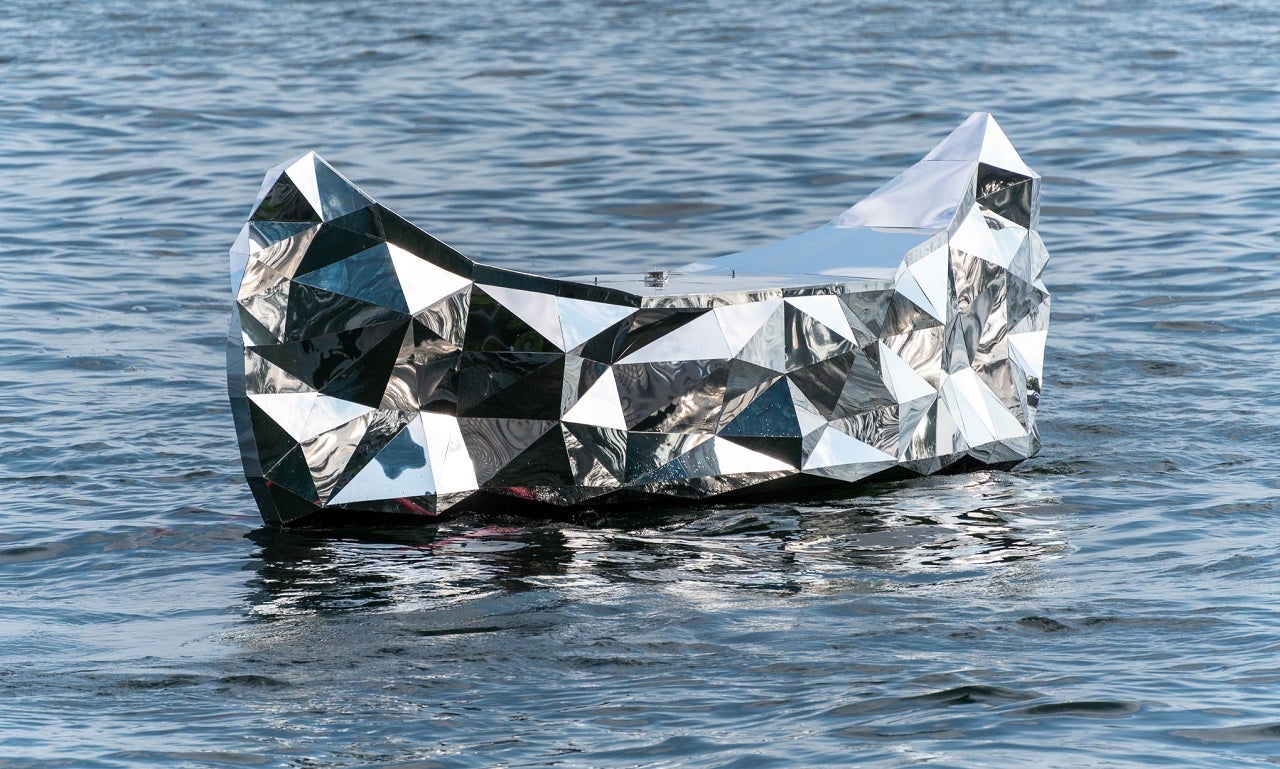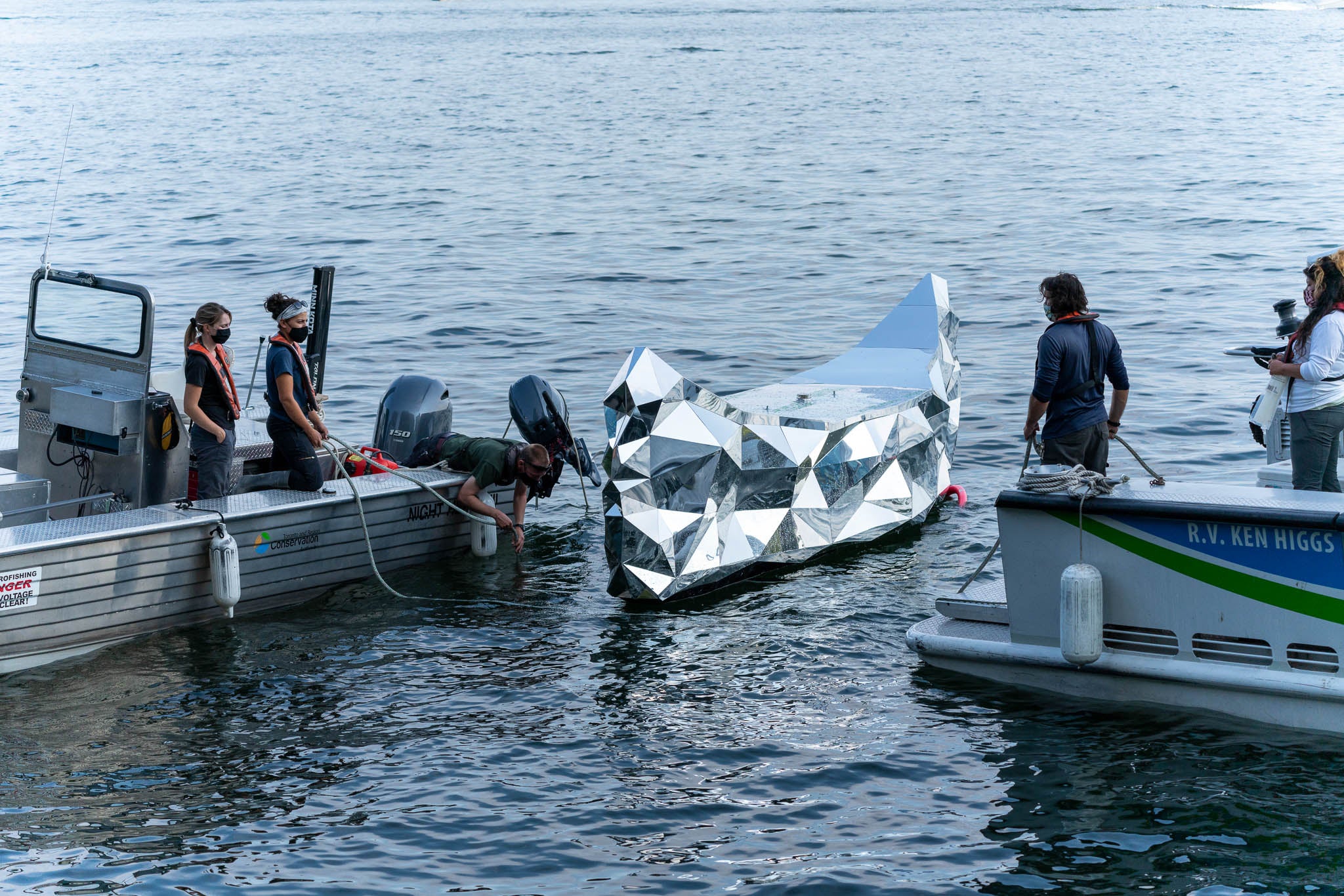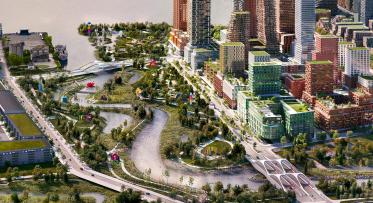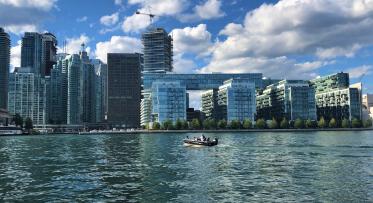The Peacemaker's Canoe

The Peacemaker's Canoe floating in Harbour Square Park basin. (Photo courtesy of Celene Tang)
POSTED: JULY 14, 2021 I PARKS AND PUBLIC SPACES, PUBLIC ART
By: Jay Havens
Following Waterfront Toronto's open call for a floating art installation in Harbour Square Basin, Jay Havens’ proposal for a piece about the Haudenosaunee story of The Peacemaker was selected. This piece will be featured in the space for six to eight weeks, from July to September 2021.
Jay Havens is a two-spirit artist of Haudenosaunee and Scottish Canadian ancestry and a proud citizen of the Mohawk Nation from the Grand River Territory. Jay’s practice embraces re-learning the ways of his Onkwehon:we ancestors and un-learning ways which go against natural cycles as his lifelong adventure and continuous challenge.
Part of Waterfront Toronto’s Temporary Public Art Program, this public art installation is indicative of the diversity on the waterfront and across the city. Through this initiative we are engaging a greater diversity of artistic voices to help reimagine and shift our relationship to and understanding of our landscape and shoreline. We sat down with Jay virtually to learn about this floating installation and how it came to be.

Miniature model of The Peacemaker's Canoe.
1. What was the inspiration for this floating installation?
When I saw the call for a floating artwork it was back in early 2020. Covid was rising, and everything was closing down. Like many artists last year, I lost most of my work and I thought this initiative at Waterfront Toronto would be a good way to continue storytelling but in a new form. This was also an opportunity to make artwork that comes from within my Haudenosaunee culture. Usually, on my jobs I don’t get to choose what story is being told. I was excited to propose something that could educate people in the community about the land and waters they live on. I was also inspired to get to know story of The Peacemaker more intimately and deepen my own knowledge about the area where I grew up and continue to call home.
I have been told this piece of history since I was small and have heard a number of different versions throughout the years. I was also inspired by the waters of lake Oniatari:io themselves which I have experienced countless times while moving about Haudenosaunee Territory over the years. I have the greatest respect for these fresh waters. I am humbled by their beauty and vastness every time I am in the area.


The Peacemaker's Canoe during the production process.
2. Tell us about the process of creating the piece.
This artwork could not have been possible without a number of artists collaborating over the last year. The process of making The Peacemaker’s Canoe began with a digital model of the canoe concept and also of the Harbour Square Park basin which I created as part of the application process. [Editor's note: Watch a fly-through rendering of the installation here.] I’ve been working closely with staff at Production Canada scene shop from the beginning of this project. When we found out we had made a successful proposal the next step was to make 3D printed models of the canoe concept and start figuring out how to make this idea a reality.
Believe it or not there is a 15ft repurposed canoe we found on craigslist at the centre of the sculpture. Material was added to the base canoe and then the geometric shapes have been painstakingly hand carved; the process took a huge amount of thinking through and time to make.
Next, reflective tiles were individually cut and added. Finally, a clear coating has been used to keep everything watertight. The workshop even had a special water tank in the parking lot to test that the artwork would remain balanced in the water. The final work is an amazing feat. I'd like to point out too that much of this work has been created while working remotely and in isolation from one another. Many of the people involved haven't actually met each other in person yet.

Team members worked remotely and saw progress on the installation through video calls, as seen above.
3. What would you like visitors to keep in mind when viewing The Peacemaker’s Canoe?
The Peacemaker’s Canoe is pointing to an older history that continues to exist on this land and remains not widely known. Events that have taken place here before the arrival of settlers have helped to shape the world we know today. I hope visitors to Harbour Square Park basin see this shining canoe and are inspired to learn about The Great Law and the story of The Peacemaker.
The Peacemaker was raised on these lands and the ideas he had about fair governance and democracy come from this region too. I'd also like visitors to think about some of the laws that have existed after The Peacemaker. The laws of Canada that exist even today have not benefited all people, especially our Onkwehon:we brothers and sisters. This artwork is also a reminder that The Great Law of Peace has not gone away. It is still here. The traditional council, even though it was forcibly removed in 1924 from Six Nation using laws in the Indian Act, has continued to make decisions as it always has and the central fire of the Haudenosaunee Confederacy remains at Onondaga near Syracuse, New York.

The Peacemaker's Canoe was launched into the water in the outer harbour marina and then tugged over to the Harbour Square Park basin for installation. (Photo courtesy of Celene Tang)
4. Can you describe the story of The Peacemaker?
I couldn’t describe the whole story here because it is too long to do justice to in a paragraph. The floating artworks represents only a small piece of this much longer narrative which involves not only The Peacemaker himself but also several other key figures such as Ayenwatha and clan mother Tyekonhsase.
This artwork represents the moments in the narrative that The Peacemaker builds a shinning canoe because he has been given a message that will quell the turbulent times his world was in. He builds the canoe so that he may depart from his homeland and his people to take the new shinning canoe to the opposite side of Oniadari:io. I imagine Ayenwatha witnessing The Peacemaker’s arrival while standing on the shoreline and first seeing a glimmering light and then the form of a canoe coming from across the water. After The Peacemaker and Ayenwatha meet they eventually form an alliance and together, over the course of the rest of the narrative, they are able to unite under one law the Mohawk, Oneida, Cayuga and Seneca and the lastly the Onondaga Nations. Through this, the Haudenosaunee Confederacy is formed and, to sanctify the new law, they plant a Great Tree of Peace over their weapons of war and destruction. Like I was saying, this history is worth knowing and I suggest anyone or everyone who lives in Tkaronto and beyond take a look or read about The Peacemaker and Haudenosaunee democracy.
Below are additional resources to learn more about the story of The Peacemaker:
- Short Video: The Story of The Peacemaker on PBS
- Books: The Rotinonshonni by Brian Rice and Kayanerenkó:wa: The Great Law of Peace by Paul Williams
- Children’s Book: Hiawatha and The Peacemaker by Robbie Robertson, David Shannon (Illustrations)
Keep an eye out for The Peacemaker's Canoe when you're in Harbour Square Park and follow Waterfront Toronto on Twitter, Facebook, Instagram and LinkedIn for the latest updates on public art along the waterfront.



